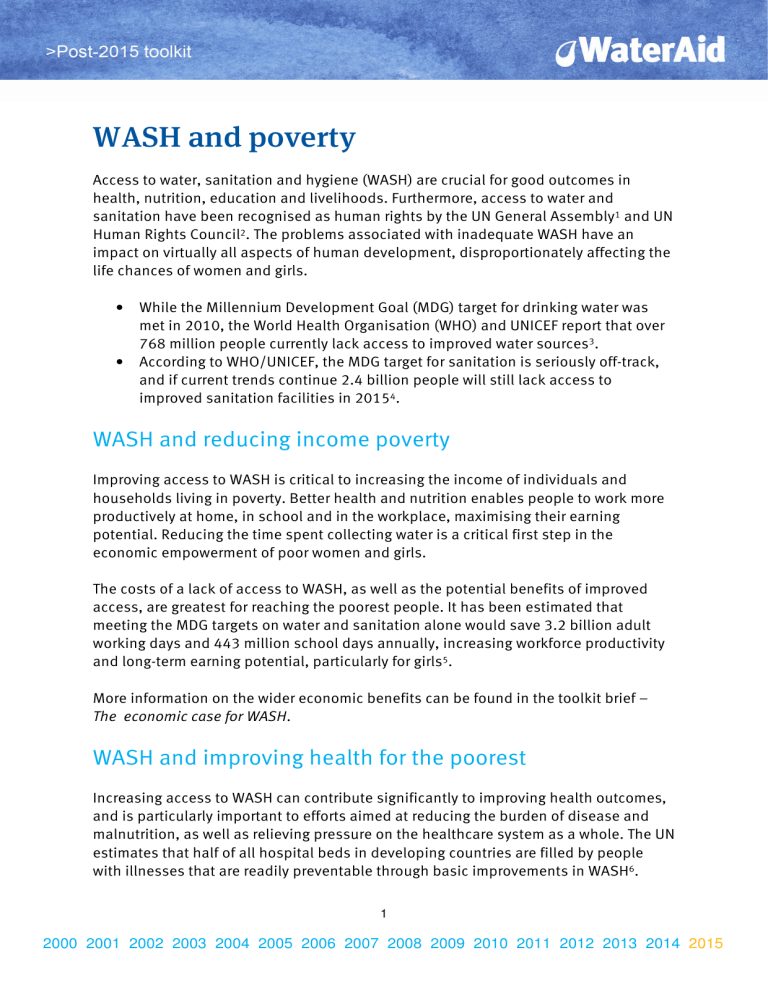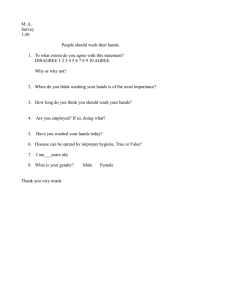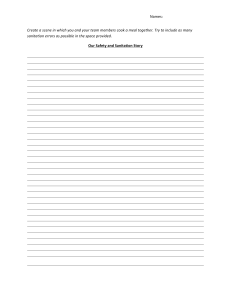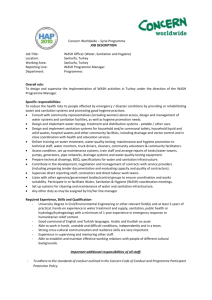
WASH and poverty Access to water, sanitation and hygiene (WASH) are crucial for good outcomes in health, nutrition, education and livelihoods. Furthermore, access to water and sanitation have been recognised as human rights by the UN General Assembly1 and UN Human Rights Council2. The problems associated with inadequate WASH have an impact on virtually all aspects of human development, disproportionately affecting the life chances of women and girls. • • While the Millennium Development Goal (MDG) target for drinking water was met in 2010, the World Health Organisation (WHO) and UNICEF report that over 768 million people currently lack access to improved water sources3. According to WHO/UNICEF, the MDG target for sanitation is seriously off-track, and if current trends continue 2.4 billion people will still lack access to improved sanitation facilities in 20154. WASH and reducing income poverty Improving access to WASH is critical to increasing the income of individuals and households living in poverty. Better health and nutrition enables people to work more productively at home, in school and in the workplace, maximising their earning potential. Reducing the time spent collecting water is a critical first step in the economic empowerment of poor women and girls. The costs of a lack of access to WASH, as well as the potential benefits of improved access, are greatest for reaching the poorest people. It has been estimated that meeting the MDG targets on water and sanitation alone would save 3.2 billion adult working days and 443 million school days annually, increasing workforce productivity and long-term earning potential, particularly for girls5. More information on the wider economic benefits can be found in the toolkit brief – The economic case for WASH. WASH and improving health for the poorest Increasing access to WASH can contribute significantly to improving health outcomes, and is particularly important to efforts aimed at reducing the burden of disease and malnutrition, as well as relieving pressure on the healthcare system as a whole. The UN estimates that half of all hospital beds in developing countries are filled by people with illnesses that are readily preventable through basic improvements in WASH6. 1 2000 2001 2002 2003 2004 2005 2006 2007 2008 2009 2010 2011 2012 2013 2014 2015 Promoting sanitation and hygiene is highly cost effective, especially when combined with other health interventions. Studies by the World Bank show that hygiene promotion saves an estimated 333 disability-adjusted life years for every $1,000 spent7. More information on the linkages to health outcomes can be found in the toolkit brief – WASH and health. WASH and improving nutrition for the poorest The WHO estimates that 50% of malnutrition is associated with repeated diarrhoea or intestinal infections, as a result of unsafe water, inadequate sanitation or insufficient hygiene8. Improved WASH is therefore essential to ending hunger. Improvements in water and sanitation services and hygiene behaviour can be crucial in breaking a vicious cycle where chronically malnourished children are more susceptible to infections generated by inadequate WASH, and in turn become even less capable of absorbing vital nutrients. With improved sanitation and a secure, safe water supply, communities are not only better able to avoid illness, they can also invest the time previously spent fetching water in growing nutritious food, such as fruit, vegetable and pulses. This improves household food security, and where a surplus is available, can even provide additional income. More information on the linkages to nutrition can be found in the toolkit brief – WASH and nutrition. WASH and inequalities between rich and poor To eradicate poverty, it is crucial that the benefits of investment in WASH reach the entire population, particularly the poorest and most vulnerable. Unfortunately, overall progress towards the MDG targets for water and sanitation has masked significant and growing disparities in access between countries, rich and poor, and urban and rural communities. The lack of attention on reducing inequality is widely recognised as one of the major shortcomings of the MDGs. If the post-2015 development framework is to be successful in eradicating poverty then it is essential that it tackles inequality head on and that goals and targets, including those relating to WASH, have an explicit focus on progressively eliminating inequalities between poor and marginalised groups and the general population. More information on the links with inequalities can be found in the toolkit briefs – WASH and inequalities and WASH and gender equality. 2 2000 2001 2002 2003 2004 2005 2006 2007 2008 2009 2010 2011 2012 2013 2014 2015 WaterAid’s post-2015 vision WaterAid’s vision for post-2015 is an ambitious new development framework unifying poverty eradication and sustainable development objectives, supported by a renewed global partnership ensuring effective resource mobilisation and mutual accountability for progress achieved. To ensure that everyone, everywhere has access to safe water, sanitation and hygiene (WASH) the framework should: 1 Include a dedicated goal on water and sanitation and set ambitious targets to achieve universal access to WASH by 2030 that prioritise the following9: • • • • No-one practises open defecation. Everyone has safe water, sanitation and hygiene at home. All schools and health facilities have safe water, sanitation and hygiene. Water, sanitation and hygiene are sustainable and inequalities in access have been progressively eliminated. 2 Recognise that universal access to WASH is an essential component of an integrated approach to tackling poverty, hunger, ill-health and inequality. 3 Recognise that achieving and sustaining universal access to WASH depends on establishing accountable systems for equitable and sustainable management of water resources. Endnotes Resolution 64/292, adopted by the UN General Assembly, 28 July 2010 Resolution 15/9 Human rights and access to safe drinking water and sanitation, adopted by the UN Human Rights Council, 30 September 2010 3 WHO/UNICEF Joint Monitoring Programme (2013) Progress on drinking-water and sanitation, 2013 update. Available at: www.wssinfo.org/fileadmin/user_upload/resources/JMPreport2013.pdf 4 WHO/UNICEF Joint Monitoring Programme (2013) Progress on drinking-water and sanitation, 2013 update. Available at: www.wssinfo.org/fileadmin/user_upload/resources/JMPreport2013.pdf 5 Hutton G (2012) Global costs and benefits of drinking water supply and sanitation interventions to reach the MDG target and universal cover, p5. World Health Organisation, Geneva, Switzerland 6 United Nations Development Programme (2006) Human development report 2006, p45 7 World Bank (2006, 2nd ed) Disease control priorities in developing countries 8 World Health Organization (2008c) Safer water, better health: Costs, benefits and sustainability of interventions to protect and promote health. Available at: http://whqlibdoc.who.int/publications/2008/9789241596435_eng.pdf 9 WHO/UNICEF Joint Monitoring Programme shared vision for progressive realisation of the human right to water and sanitation. See www.wssinfo.org/post-2015-monitoring/overview for full technical proposals for post-2015 WASH targets and indicators. 1 2 3 2000 2001 2002 2003 2004 2005 2006 2007 2008 2009 2010 2011 2012 2013 2014 2015






